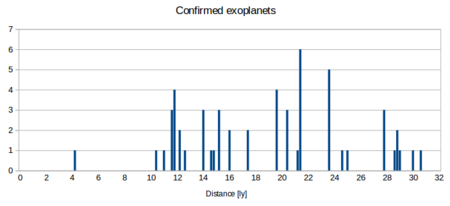
Back قائمة أقرب الكواكب غير الشمسية Arabic فهرست سیارههای فراخورشیدی نزدیک Persian 地球に近い太陽系外惑星の一覧 Japanese Lista över närmaste exoplaneterna Swedish En yakın ötegezegenler listesi Turkish 近地系外行星 Chinese


There are 6,660 known exoplanets, or planets outside the Solar System that orbit a star, as of July 1, 2024; only a small fraction of these are located in the vicinity of the Solar System.[3] Within 10 parsecs (32.6 light-years), there are 106 exoplanets listed as confirmed by the NASA Exoplanet Archive.[note 1][4] Among the over 500 known stars and brown dwarfs within 10 parsecs,[5][note 2] around 60 have been confirmed to have planetary systems; 51 stars in this range are visible to the naked eye,[note 3][7] eight of which have planetary systems.
The first report of an exoplanet within this range was in 1998 for a planet orbiting around Gliese 876 (15.3 light-years (ly) away), and the latest as of 2024 is one around GJ 1289 (27.3 ly). The closest exoplanets are those found orbiting the star closest to the Solar System, which is Proxima Centauri 4.25 light-years away. The first confirmed exoplanet discovered in the Proxima Centauri system was Proxima Centauri b, in 2016. HD 219134 (21.6 ly) has six exoplanets, the highest number discovered for any star within this range.
Most known nearby exoplanets orbit close to their stars. A majority are significantly larger than Earth, but a few have similar masses, including planets around YZ Ceti, Gliese 367, and Proxima Centauri which may be less massive than Earth. Several confirmed exoplanets are hypothesized to be potentially habitable, with Proxima Centauri b and GJ 1002 b (15.8 ly) considered among the most likely candidates.[8] The International Astronomical Union has assigned proper names to some known extrasolar bodies, including nearby exoplanets, through the NameExoWorlds project. Planets named in the 2015 event include the planets around Epsilon Eridani (10.5 ly) and Fomalhaut,[note 4][11] while planets named in the 2022 event include those around Gliese 436, Gliese 486, and Gliese 367.[12]
- ^ Harrington, J. D.; Villard, Ray (2013-08-01). "NASA's Hubble Reveals Rogue Planetary Orbit For Fomalhaut". NASA. Archived from the original on 2015-11-06. Retrieved 2015-09-18.
- ^ Cite error: The named reference
PNAS-20200420was invoked but never defined (see the help page). - ^ Cite error: The named reference
Encyclopaediawas invoked but never defined (see the help page). - ^ a b Cite error: The named reference
NASAedwas invoked but never defined (see the help page). - ^ a b Cite error: The named reference
Reylé2021was invoked but never defined (see the help page). - ^ Cite error: The named reference
nakedeyewas invoked but never defined (see the help page). - ^ Cite error: The named reference
autogenerated2was invoked but never defined (see the help page). - ^ Cite error: The named reference
PHLwas invoked but never defined (see the help page). - ^ "epsilon Eridani". NameExoWorlds. International Astronomical Union. Archived from the original on 2018-02-15. Retrieved 2018-05-14.
- ^ "Fomalhaut (alpha Piscis Austrini)". Nameexoworlds. International Astronomical Union. Archived from the original on 2017-04-30. Retrieved 2018-05-14.
- ^ a b Cite error: The named reference
IAUpollwas invoked but never defined (see the help page). - ^ Cite error: The named reference
NEW2022was invoked but never defined (see the help page).
Cite error: There are <ref group=note> tags on this page, but the references will not show without a {{reflist|group=note}} template (see the help page).
© MMXXIII Rich X Search. We shall prevail. All rights reserved. Rich X Search